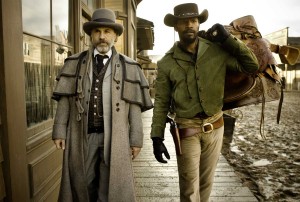
One day costume designer Sharen Davis mysteriously received a call to design for director Quentin Tarantino’s spaghetti western Django Unchained starring Jamie Foxx as the titular character. It came as a surprise since she didn’t know the director or any of the producers. Although it was hardly puzzling how Davis came to be on their radar. After all, her prolific work throughout the years is impressive, having designed for the notable film The Help just last year, not to mention her duo Academy Award nominations, for Ray in 2004, (which also starred Jamie Foxx) and Dreamgirls in 2006.
Davis threw her energies into the curious world of Django Unchained and set out for the adventure much like Django himself. She took her cues from Italian spaghetti westerns which she immersed herself in during the research process. The film, set in the 1850s encompassed two worlds – one of the genteel south, and another of the pioneer on the frontier. Davis approached both worlds with a sense of freedom to design the costumes with a flair toward expressing the characters rather than an oppressive adherence to historical accuracy.

Perhaps the most obvious presentation of this effort can be seen when Django begins his masquerade as a valet. The former slave has been given an opportunity to select his own clothing and his choice is equal parts telling and outrageous. “The blue valet suit is a liberty,” said Davis. “ A lot of valets actually wore outfits like that during that time. It wasn’t with the big bow, [which is flaunted in Django’s suit], but they did wear the knickers and the pants. It was weird to see someone who was a slave one minute come out with that the next minute.”

Attention to details and to the eccentric story was sometimes a challenge in the sheer magnitude of the job. Even dressing a series of outlaw gangs that appear in the film only briefly wasn’t just a passing task. “There were so many men in this film that had to be so specific in looks,” Davis explained. “It was very hard to come up with new concepts to make them different and also keep it in the style of a spaghetti western. Most of the costumes were made to order.” But the peculiarities of dressing characters in such an over-the-top manner was also a delightful experience. “The whole thing was fun. The whole thing was a giant puzzle. It all fits together in a very strange way.”
“I went to see the film and I got so caught up seeing the film, I didn’t notice my work,” she said. It’s no wonder since the effect of costume design is evidenced in the way it integrates into the story and assists in telling the story as opposed to standing out on its own.





